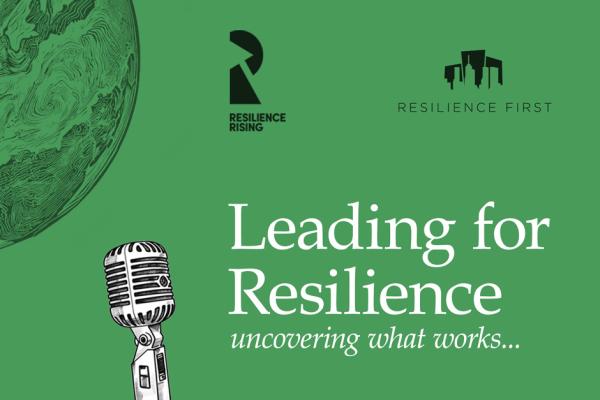'To adapt and thrive in times of accelerating change, businesses must have the right leadership, behaviours and be connected into their communities.'
These are among core findings from the recent survey of UK business leaders jointly carried out by Resilience First and EY and recently launched to an audience of resilience leaders at EY’s London office. A summary can be found here:
Fiona Twycross AM, Deputy Mayor for Fire and Resilience at the Greater London Authority (GLA), welcomed the research as a timely contribution to resolving what needs to be done not only to survive but also to adapt and thrive after major disruptive events.
Fiona found it reassuring the results recognise that people are the bedrock of resilience and that the importance of community, culture and leadership mean resilience must be dealt with at board level.
She also noted the steep challenge to embed resilience into mainstream of business thinking, particularly for smaller businesses.
She said involvement in the global resilience community of Rockefeller Foundation's 100 Resilient Cities initiative has helped the GLA to embed resilience into every aspect of London’s operation.
“Resilience is about the ability to learn from disruptive events – not just to survive but also to adapt, grow and thrive”, said Fiona. “This counts for whole cities and for businesses of all sizes within those cities. Learning from incidents and continually improving the way we manage major events has built London’s resilience.”
The survey showed the extent to which business success relied on the robustness of supply chains and Fiona noted this was a major focus in London’s Brexit ‘no deal’ planning. Work to understand and map potential disruption and costs in preparation for Brexit has had a big impact on broader thinking about the city’s resilience.
“Our Brexit planning has helped to change thinking about resilience across a range of potential threats, and highlighting the critical importance of supply chains”, said Fiona.
Beyond Brexit, there many events – weather, seismic, terror or technological – that could impact supply chain. Fiona said that whatever the outcome of Brexit, the City had learned a great deal from the planning process that can be applied to many forms of shock and disruption.
Kevin Duffy, Managing Director of Cyber Rescue, led a discussion on managing cyber risk in supply chains, based on responses and discussion around to three questions.
- Among your business resilience concerns, where do you rank Cyber Risk?
100 per cent of respondents put cyber risk in their top five resilience concerns, with 57 per cent rating it in the top three. The discussion turned to managing cyber risk in supply chains. It was widely acknowledged that achieving standards throughout the supply chain took two-way commitment and quality of relationships.
“To get expertise into the supply chain, you must engage with them and educate them.”
- Do you require key suppliers to comply with cyber standards?
90 per cent of respondents said yes. However, the room overwhelmingly held that complying with standards is not enough, it is key to build quality of relationships from the start. There was broad agreement of the need to ensure that compliance did not turn into a mere box ticking exercise.
“Capability and maturity won’t be revealed by compliance with standards.”
- Should your business verify that all your key suppliers are compliant with cyber standards?
87 per cent of respondents said they verified compliance with cyber standards at least annually. However, the room strongly held that verification of compliance was not enough. Mutual respect and engagement were needed to educate and build trust along the supply chain.
“Your suppliers are part of your community. You share common goals: growth and resilience. You have create a culture of mutual respect”
Robert Hall, Executive Director, Resilience First, presented the survey’s findings in relation to People and Communities. “It’s not just ‘do I know my neighbour’? Your behaviour will influence your survival.”
He said the report has come at a crucial cross road when climate change, Brexit and societal change are causing pressures to build fast. To influence that uncertainty, resilience was coming to the fore and people were at the core of how to respond:
- People are the bedrock of a resilient response to risk, serious events and the uncertainty they bring.
- The soft skills of resilience are crucial but hard to deploy. People need to be coached and taught standards for leadership, empowerment, building community and behaviours.
- Building social capital in crucial. By generating trust, engagement and connections recovery is faster and greater than it is without them.
Robert was concerned the research results around community show “a bottle half full”. 49 per cent is great but it meant that 51 per cent were not paying attention to their communities. It’s not just ‘do I know my neighbour?’. Your behaviour will influence your survival,” said Robert.
He agreed with Fiona that London was resilient, not just for its infrastructure but for its people. However, he questioned how we would respond to the disastrous impact of an event like the floods in Dhaka or major water shortages. Would we be so resilient?
Dr Paul Robinson, EY Director Cybersecurity, Privacy and Resilience, presented the research finding in relations to Finance and Regulation. “How early are the resilience professionals engaged? Are you part of investment decision making or just bolted on at the end, when you have to shore up against the decisions already made?”
Paul believed the more dramatic numbers indicated foreboding issues that needed to be tackled urgently and he was concerned the Brexit risk was being outsourced to supply chains, along with the financial and investment decisions to secure resilience.
“Beyond London we rely on a global ecosystem, we are not only reliant on our own investment and resilience decisions.”
He also questioned at what level resilience professionals were being engaged in resilience investment decisions. “Are we bridging the gap between the Boardroom and the resilience conversation: from a focus on operations to being at the table to influence investment decisions?”
Tom Brady, EY Senior Consultant, Cybersecurity Privacy and Resilience, presented the findings on Technology.
Organisations making the move to could technology emerged as a strong theme. Tom emphasised the importance of top-down strategy and policies for any technology investment, and in making the decision to move to cloud technology he underlined the importance of clear objectives and detailed planning.
He warned of an increasing rate of data centre outages and severity of down time, and that the more complex your supply chain the more deeply you must delve to understand risks within it.
Tom noted that while 88 per cent of businesses have processes in place to assess the likely impact of major disruption, only 45 per cent have processes in place to mitigate them.
A panel Q&A followed the presentations.
A final comment from the floor emphasised the importance of business taking responsibility for resilience and building community in order to survive and thrive.
“Governments should not have to regulate when organisations are coming together to create and support solutions.”
For further reading, please visit our Knowledge Hub.



